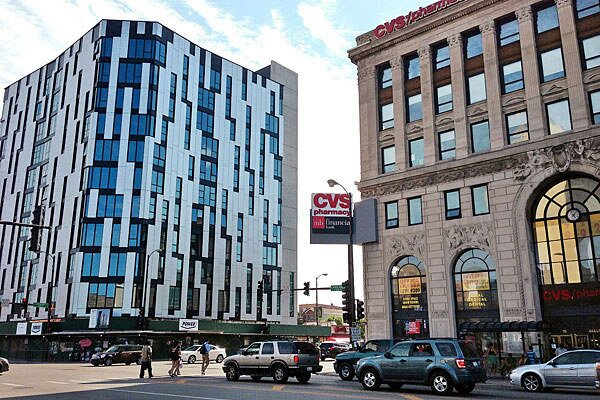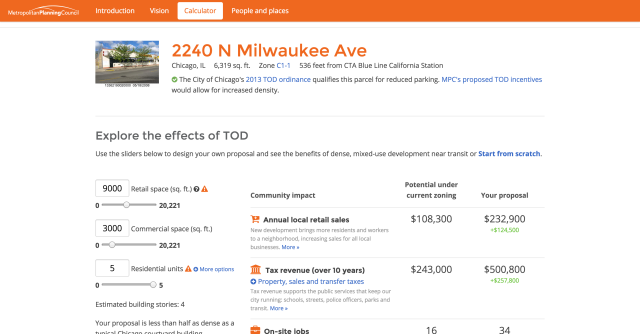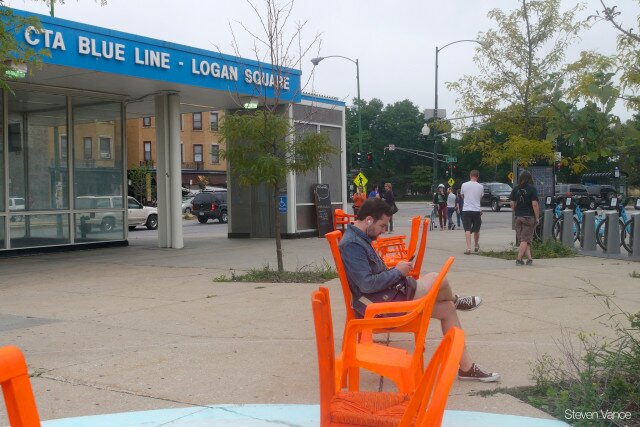 At the last ChiHackNight, Yonah Freemark and Ryan Griffin-Stegink from the Metropolitan Planning Council gave a demonstration of Grow Chicago, a new website the Metropolitan Planning Council uses to advocate for transit-oriented development in the Chicago region.
At the last ChiHackNight, Yonah Freemark and Ryan Griffin-Stegink from the Metropolitan Planning Council gave a demonstration of Grow Chicago, a new website the Metropolitan Planning Council uses to advocate for transit-oriented development in the Chicago region.
Transit Oriented Development, sometimes shortened on Twitter to #TOD, is when a city zones the land with the intent of making the area more walkable. In practical terms, this means lowering the parking space requirement for buildings and enabling the development of pedestrian streets.

1611 W Division, photo courtesy of Streetsblog Chicago
An example of transit oriented development is the 1611 W Division apartment building in the Wicker Park neighborhood. The building sits on top of a CTA Blue Line station. For a building of it’s size, it would normally require a large parking structure. However, because it sits in a transit oriented development zone it doesn’t need one. The last ordinance that allowed for Transit Oriented Development was passed in 2013 with a new proposal to expand the areas currently being proposed by Mayor Emanuel.
As part of an effort to help promote Transit Oriented Development, MPC built Grow Chicago to help residents understand the impact of Transit Oriented Development.
The first part of the site helps users understand the benefits of transit oriented development. For example, people who live in TOD areas drive 40% less and tend to take more public transit.
The second feature lets you choose an area that’s been zoned for TOD and use sliders to determine the impact of different proposals. For example, for the 2240 N Milwaukee site a development that has 9000 square feet of retail and five stories of residential units will produce about $500,00 in tax revenue. Even at that density, the development would only be half as dense as the typical Chicago courtyard building. However, that type of development would only be allowed under MPC’s proposed recommendations.
 Even if you don’t have a specific address you’re curious about, you can use the app just to play around with any address.
Even if you don’t have a specific address you’re curious about, you can use the app just to play around with any address.
The site also lists several case studies and examples of how transit oriented developments has helped communities.
To build the app, the Metropolitan Planning Council hired local firm Webitects. (As a side note, the very first Chi Hack Night happened at their offices.)
The app uses data from Chicago Cityscape to help populate property information.
To get more information the campaign for transit oriented development go to http://growchicago.metroplanning.org/.
 At the last ChiHackNight, Yonah Freemark and Ryan Griffin-Stegink from the Metropolitan Planning Council gave a demonstration of Grow Chicago, a new website the Metropolitan Planning Council uses to advocate for transit-oriented development in the Chicago region.
At the last ChiHackNight, Yonah Freemark and Ryan Griffin-Stegink from the Metropolitan Planning Council gave a demonstration of Grow Chicago, a new website the Metropolitan Planning Council uses to advocate for transit-oriented development in the Chicago region.
 Even if you don’t have a specific address you’re curious about, you can use the app just to play around with any address.
Even if you don’t have a specific address you’re curious about, you can use the app just to play around with any address.
